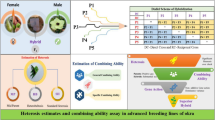Abstract
Assessing breeding potential of multi-parent crosses is essential in order to isolate inbreds with broad genetic base. Five parental lines of chilli were used to produce ten single-cross hybrids in diallel design. These ten single crosses were in turn used to produce 15 double-cross hybrids and 30 three-way cross hybrids. The breeding potential of these three-way cross and double-cross hybrids was assessed for fruit yield per plant in terms of quantitative traits means, variances and their ability to produce transgressive segregants. Rank sums were also calculated based on individual means and variance. The hybrids which showed better values for all these parameters were compared and inferred that (Byadagikaddi × Gouribidanur) × (CCA 9907-9611 × Tiwari) and (CCA 9907-9611 × Tiwari) × PBC 483 have highest breeding potential and hence can be utilized for further improvement.




Similar content being viewed by others
References
Chahal GS, Gosal SS (2002) Principles and procedures of plant breeding. Narosa Publishing House, New Delhi
Choo TM, Kotecha A, Reinbergs E, Song LSP, Fejer SO (1986) Diallel analysis of grain yield in barley using doubled haploid lines. Plant Breed 97:129–137
Fasoulas A (1981) Principles and methods of plant breeding. Publication no. 11. Department of Genetics and Plant Breeding, Aristellian University of Thessaloniki, Thessaloniki
Khan R, Dubey RB (2015) Combining ability analysis for nutritional quality and yield in maize (Zea mays L.). The Bioscan 10(2):785–788
Krishnappa M, Ramesh S, Chandraprakash J, Jayarame G, Doss DD (2009) Breeding potential of selected crosses for genetic improvement of finger millet. J SAT Agric Res 7:1–6
Lakshmi Pathy T, Mohan Rao A, Ramesh S (2016) Heterosis and combining ability studies in Chilli (Capsicum annuum L.) by diallel Analysis. Adv Life Sci 5(21):9778–9780
Reddy MK, Srivastava A, Kumar S, Kumar R, Chawda N, Ebert AW, Vishwakarma M (2014) Chilli (Capsicum annuum L.) breeding in India: an overview. SABRAO J Breed Genet 46:160–173
Roy D (2000) Plant breeding—analysis and exploitation of variation. Narosa Publishing House, New Delhi
White-house RNH (1969) An application of canonical analysis to plant breeding. Genet Agrar 23:61–69
Acknowledgements
Authors are grateful to Indian Council of Agricultural Research (ICAR) for providing financial assistance through Junior Research Fellowship (JRF).
Author information
Authors and Affiliations
Corresponding author
Rights and permissions
About this article
Cite this article
Lakshmi Pathy, T., Mohan Rao, A. & Ramesh, S. Assessing Breeding Potential of Three-Way Cross and Double-Cross Hybrids in Chilli (Capsicum annuum). Agric Res 7, 129–134 (2018). https://doi.org/10.1007/s40003-018-0318-6
Received:
Accepted:
Published:
Issue Date:
DOI: https://doi.org/10.1007/s40003-018-0318-6



